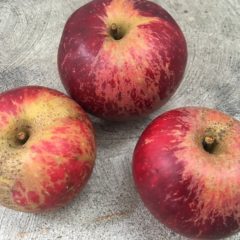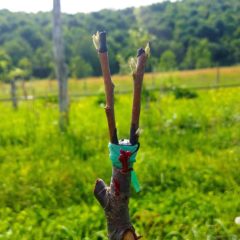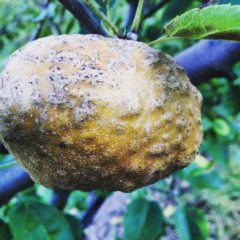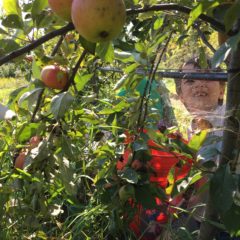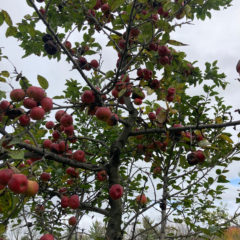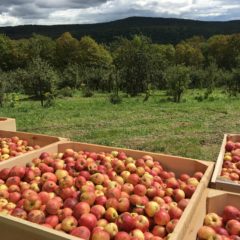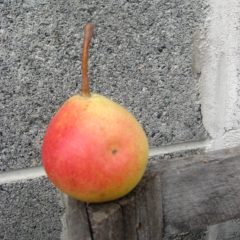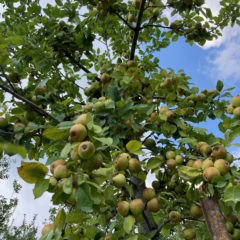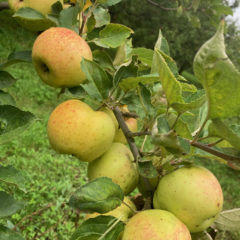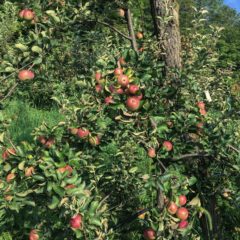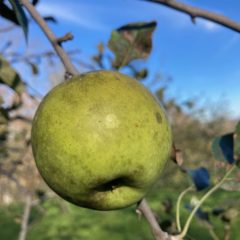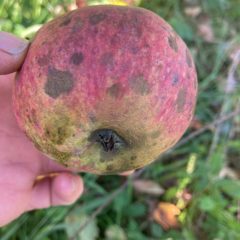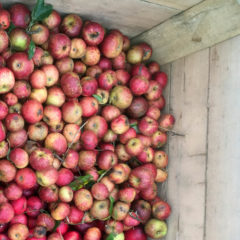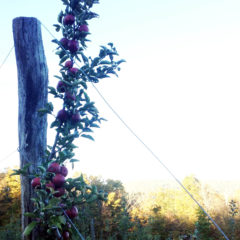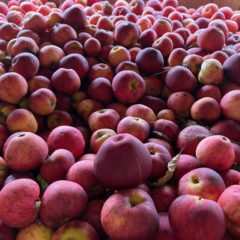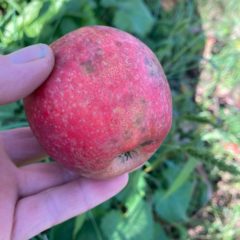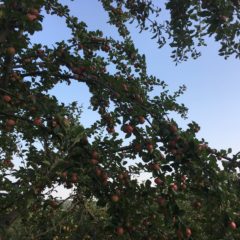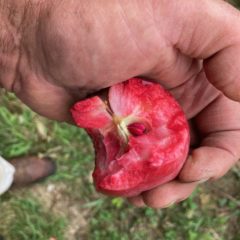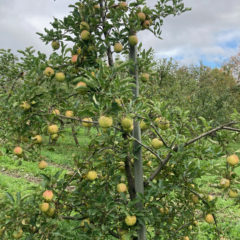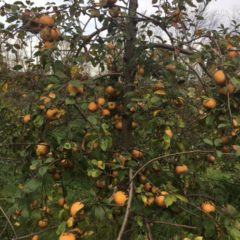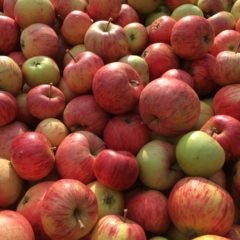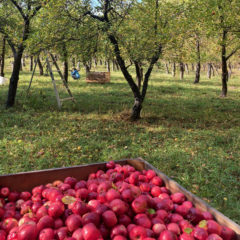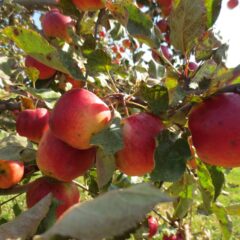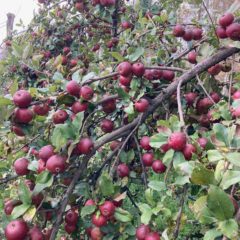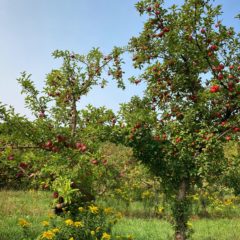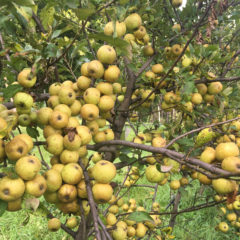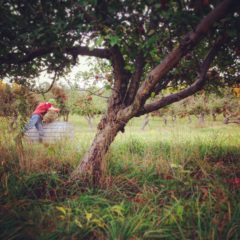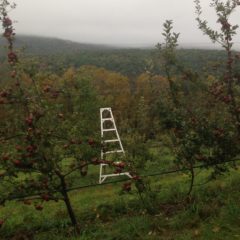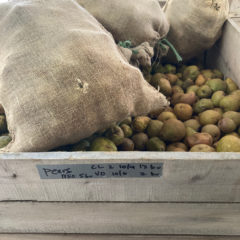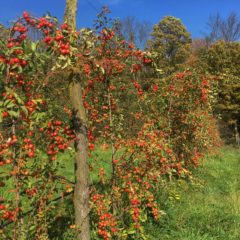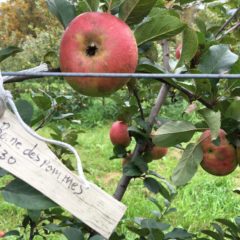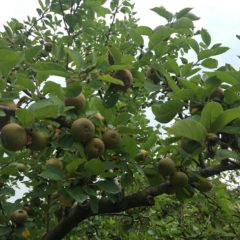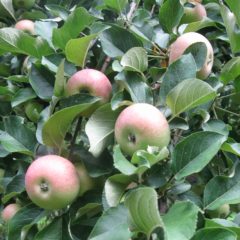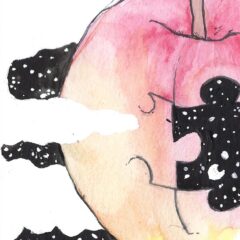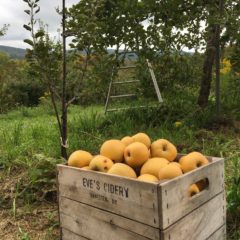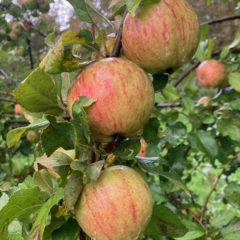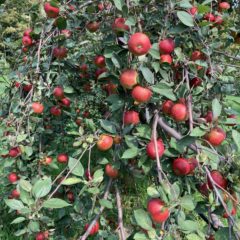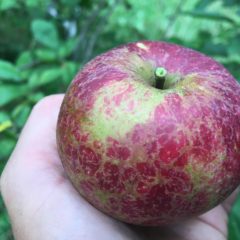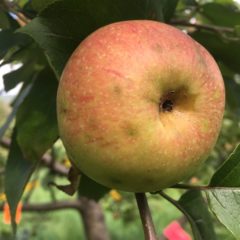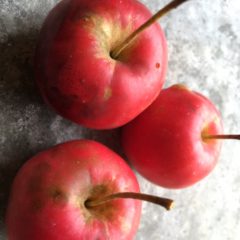Scion Wood Shop is closed for the season. Check back in January 2025!
Welcome to our pop-up Scion Wood Shop.
Order deadline is February 25th. We will cut and ship the scionwood first week of March (unless you notify us you would like them to ship later with your rootstocks). Each stick will have approximately 16 buds (if the sticks are short, we ship extra). If you would like to order more than 100 sticks, we can offer quantity discount pricing. Email Autumn for details autumnstoscheck at gmail dot com
*Scionwood are hardwood cuttings, not trees! You have to graft or bud onto rootstocks or established trees.
More deets here:
- Certified organic B118 rootstocks are grown in our orchard stoolbed. B118 is our favorite rootstock for a low input cider orchard. Our rootstocks are gown without herbicides in local hardwood chips and have lots of beautiful roots and already formed mycorhizal colonies. For orders over 100, contact Autumn autumnstoscheck at gmail dot com for discount pricing. We are shipping these as soon as we can dig them in mid-late March (digging date is weather dependent). Please let us know if you would like us to hold your scions to ship with rootstocks. Otherwise they will ship separately.
- We recommend in-situ whip and tongue grafting as a planting technique. Read more about it here.
- Scions come from our certified organic orchards. Except for a few exceptions (where noted) the scionwood is cut from bearing trees so we know for sure the variety on the tag is what it claims to be!
- Properly stored, scionwood can keep in your fridge for months.
- Flat rate shipping for scion orders to 49 US States is $15. (Alaska, sorry but we'll have to charge addition for next day air).
- Flat rate shipping for budwood is $15. (Alaska, sorry but we'll have to charge addition for next day air).
- Scion Wood Shop closes on 2/25/24
Ashmead’s Kernal (aromatic, late acid)
Floral aromas, lots of dry extract, high brix and insane acid characterize this English heirloom’s cider qualities. The tree is a shy bearer on our site.
Ashton Bitter. (early bittersweet)
Early season English bittersweet. Hard, sometimes quite bitter tannins. Useful source of concentrated tannins for September harvest.
Certified organic B118 rootstocks are grown in our orchard stoolbed. B118 is our favorite rootstock for a low input cider orchard. Considered close to standard in size, cold hardy, less attractive to voles than some, well anchored and very precocious– often beginning to bear in the 3rd year in our orchards. Unlike commercial rootstocks, these babies have lots of beautiful roots and already formed mycorhizal colonies.
Bedan (bittersweet)
Soft tannins, classic French cider aromas. Very productive but very biennial.
Binet Rouge
(soft bitterweet)
A smaller-sized tree that bears biennially. A pretty pink apple with that classic French bittersweet character.
Bramley’s Seedling. (pure acid)
The acid is a fresh, bright acid that doesn’t come across as “malic;” an important blending component useful for bringing up acidity without changing the flavor. A massive apple size makes harvest easy but this tree can easily be pushed into biennial bearing.
Brandy (precocious bittersweet pear)
The earliest to come into bearing of our English Perry pear trials. Smaller, manageable tree. High gravity tannic fruit. Fireblight susceptible.
Brown Snout (soft bittersweet)
Melt in your mouth tannins define this English bittersweet. This apple does not produce BSA in cider but has pretty aromas non the less. Late blooming and fireblight susceptible.
Brown’s Apple (sharp)
Big, red, early acid bomb with a bit of tannin. Delightful bright, fruity aromas. Strange upright growth habit. English.
Bulmer’s Norman. (bittersweet)
Precocious and productive. Tannins are hard and can be bitter and the fruit drops all at once, bruises easily and doesn’t hold well. Can make a solid tannic blending apple.
Chisel Jersey. (bittersweet)
An English bittersweet with beautiful aromas, hard tannins and a lot of bitterness. Very fireblight susceptible on our site, in part due to its extremely late blossoming.
Collaos
Newly release from quarantine Spanish cider. Has that special Spanish zingy acidity to it. Still need to do lots of eval on this.
(Spanish bittersweet)
Ian Merwin brought bud wood through USDA quarantine. Saw out first apples on these trees this year (’21). Lovely bittersweets. Looking forward to seeing more of these.
Cox Orange Pippin. (early acid, aroma)
Intensely flavored and quite tart, Cox is a nice blending apple for early September acid and nice ‘heirloom’ aromatics.
Dabinett. (bittersweet)
A beautiful example of an English bittersweet variety, Dabinett has all the attributes we want: ripe apple aromas, leather, smoke, sweat. It has nice firm tannins and good Brix, can be an annual bearer, and is very precocious and productive. So productive, in fact, that we’ve struggled to grow it right in our organic systems. It will often overcrop (the overcropped fruit is not nice) and runt out. We want this apple, so we are still figuring out how to grow it. We have a new planting on B118. Check back in 10 years.
Ellis Bitter. (bittersweet; leather, ripe apple skins, bacon)
Ripening in early September, Ellis Bitter is our main early season bittersweet. Heavenly sweet, ripe aromas backed by solid tannins. The tree is biennial in our organic production system, but when it crops it crops heavily with medium-sized fruit that drops in stages. We make multiple pickings of this variety for the best quality juice. In most years the fruit holds well on the ground if it has a nice mown sod to fall onto.
Esopus Spitzenburg (Spicy aromatic heirloom)
Another old New York apple with great cider making qualities that doubles as an aromatic and a sharp. Spitzenburg contributes plenty of acid and a spicy “old fashioned” flavor to cider.
Frequin Rouge. (concentrated BSA aromas, tannin)
This apple has incredible concentrated smoky/leather/orchard floor aromas plus a firm tannic structure. Late to come into bearing, an extremely biennial tree, high vigor and small fruit makes this tree less than ideal for modern high density plantings on fertile soil. But in more challenging sites, Frequin Rouge excels developing unique creosote aroma and a deep sense of smokiness. One of our favorite bittersweets.
Geneva Crab (Dark red flesh and juice)
For making a real rose colored cider. Highly acidic and a bit bitter, this apple needs blending but makes stunning pink juice.
Goldrush (Sweet tart high sugar acid source)
Scab resistant modern apple with high gravity and lots of acidity. Diminutive tree with a tendency to overcrop. Will last in storage for just about forever and is a fantastic eating apple. Caution: the acid has a flavor that verges on “malic” think sweet tarts candy in cider. Could be a plus or minus depending on your style.
Golden Russet. (aroma/richness)
This apple adds a very distinct set of aroma characteristics as well as beautiful richness. As a single variety, it lacks structure; but we find at about 30%-50% of the blend the cider will retain the aromatics of Golden Russet, specifically ripe melon and stone fruit. Sometimes unripe peach, white peach, ripe peach, or sometimes apricot. In addition to stone fruit, GR (in our fermentations) has a distinctive beeswax/tar/petrol quality.
Herefordshire Redstreak (early bittersharp)
Lovely petrol and ripe apple aromas. Lots of acid and nice tannins.
Idared
(red apple aromas)
Not technically a cider apple, but we like to use it in blends to layer in a red apple aroma. Good for storing, eating and cooking too.
Several on the Eve’s team list Jonagold as their number one favorite eating apple. We also love Jonagold aromatics in distilled spirits. Jonagold was bred by the Cornell breeding program in Geneva, New York. It was selected in 1943 and introduced in 1968, and it has become broadly popular in Europe.
“Kingston Black. (Elusive, exceptional)
Many folks have given up on Kingston Black. For all the hype about it being the best single variety cider, the tree is difficult to grow—lots of blind wood, slow to come into bearing, small apples, low yields, biennial. The cider, too, can be a challenge to make. The tannins can be bitter, the flavors centering around tobacco and bittersweet apple. But grown well and made well, Kingston Black cider can be revelatory: a seamless balance between tannin and acid, savory and sweet, refreshing and satisfying.”
(high acid, high sugar, high tannins)
We don’t know for sure what this variety is, but we suspect it is a M26 rootstock. A long time ago, James trained and pruned these rogue rootstocks just like the other trees in his orchard. Fittingly, he has since forgotten what he had planted and after his brain injury renamed them “Krys”. We have used this variety in our cider blends for many years. The tree produces good crops of high brix, high acid, high tannin medium sized apples on a biennial schedule. They drop when ripe and make a slow fermenting, outrageously fruity, high intensity cider. The tree is the ugliest thing you have ever seen, with copious burr knots and fat gnarled spurs, once it settles down. Before it settles down it grows vigorous, upright shoots with no apical dominance. You have been warned.
Liberty is primarily a fresh eating apple, but we use it occasionally in blends to add an aromatic punch. It’s one of those varieties that ferments into an aroma that is remarkably similar to the fresh apple. It is a scab resistant cross of Macoun by a malus floribunda offspring, bred at the Geneva Experiment Station in the 1950s. A diminutive tree that crops heavily and annually.
Major (very early bittersweet)
Ripens in late August/early September. Soft and fruity aromas and nice tannin. Prone to summer rots.
Medaille d’ Or (High gravity high tannin bittersweet)
Fireblight susceptible, late blooming french bittersweet with loads of biennial golden fruit.
Newtown Pippin
(American Heirloom)
Tart green apple of much fame. Stores well and good for eating too.
Northern Spy. ( Minerality: salt and shale)
We love NS for its minerality; however, this is definitely one of those apples that is fairly insipid when grown and harvested like dessert fruit in the wrong location. Our Spy is specifically the original strain, not “Red Spy” which ferments very differently. It has a neutral sort of fresh/unripe apple aroma when fermented that verges into a salty/ shale austerity. Grown on our dry gravelly ground, it has a refreshing acid-tannin component that is very much wet stone. We often use this as the last blending component; a blend that has the right structure and aromatics will often take on a new level of depth with 10% or 15% Northern Spy.
Pink Pearl (Pink flesh and light pink juice)
More high acid pink juice for real rose colored cider.
Porter’s Perfection (Intensely fruity, fresh, petrol, bright acid)
We are pretty excited about how this apple (often identifiable by its fused fruits) seems to express petrol and mineral characteristics on our Van Etten site. This apple also has BSA aromas, as well as a bright fresh acid. Porter’s makes a exceptional single variety cider that is both bright and fruity and dense and minerially. One of our favorite apples.
We like to add a certain amount of highly aromatic dessert pears to our otherwise tannic perry, and to pear based distilled spirits. Potomac is a good one because it is highly fireblight resistant. A droup pear with lovely, delicate aroma when fully ripe.
Puget Spice (High gravity tannin acid bomb)
One of the most disease resistant trees in our orchard. Ping pong ball size apples easily shake off the tree when ripe in the late fall. Lots of sugar, lots of tannin, lots of acid.
Reine des Pommes (bittersweet)
Lots and lots of tannin in these perfumed apples. Classic BSA.
Reinette Zabergau (German Russet)
Large, easy to harvest russets with more acid than Golden Russet and similar but different classic russet flavor profile.
Roxbury Russet (classic russet flavor)
Russet’s as a group tend toward beeswax, honey, ripe melon and stone fruit. Roxbury is no exception. Perhaps the oldest “American” variety.
Galerina (Spanish)
Haven’t fruited yet. Just a little bit of scion wood to share with experimentalists.
Somerset Redstreak (fruity bittersweet)
Absolutely love the beautiful fruity aromas on this English bittersweet. Early to mid September harvest. Very biennial.
A giant triploid apple, Spigold is a cross of Northern Spy and Golden delicious, bred at Cornell Geneva, selected in 1944 and introduced in 1962.
Spigold retains some of the minerality of Spy, with Golden Delicious aromatics. We have made a single varietal Spigold for years…with a very champagne-like flavor profile.
Saint Edmund’s Russet (early heirloom aromatics)
Delicious tropical aromas, plus density and balanced acid. A lovely, weeping growth habit and regular annual bearing. Resistant to scab but will crack with excessive swings in ground moisture.
Stembridge Cluster, (bittersharp, with “petrol” qualities)
Nice soft tannin and great acidity. This variety is excellent for cider, but biennial bearing.
Stoke Red (Early fruity acid and tannin)
This strongly biannual bittersharp has a lovely bright-fruit characteristic.
Tydeman’s Worcester Early. (aromatics)
This apple drops all at once in late August. Be there or be square. Basically a summer apple with relatively low sugar, we prize this apple for the intensely pretty aromatics it will contribute to cider.
Vilberrie (Perfumed and tannic)
This extremely late blooming French bittersweet is extremely perfumed with the classic “BSA” aromas we love in French cider apples. High sugar tannin bomb that is susceptible to fireblight.
Virginia (Hewe’s) Crab. (aromatics, tannins, acid)
As the climate warms, we find ourselves drawn more and more to this apple from the southern end of our Appalachian mountains. Brix on this gem ranges from 16 to 20, depending on the year on our site. Besides having beautiful tannins, this apple contributes sheer energy to cider. A fresh aliveness that’s unique. Virginia Crab really is a crab…it’s small, and the juice yields are frustratingly low, but it bears annually and the fruit is super concentrated. Blooms early, ripens early, and it very susceptible to scab.

